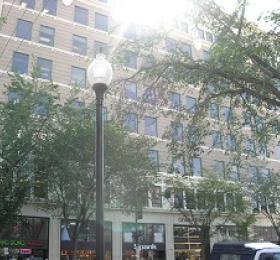Canada Building
- Holding Bylaw
The Canada Building is an eight storey Chicago style office building that was constructed in 1912. Located on the south-east corner of 21st Street and 1st Avenue, the Canada Building continues to be one of the most attractive buildings in the city’s downtown.
This historic place, located at 105 21st St East, is listed under Bylaw No. 6770 (Holding Bylaw). This Bylaw provides short-term protection of the building from demolition by providing for a 60 day holding period in the event a demolition permit is received. Within that 60 day period heritage designation is considered by City Council.
Heritage Value
The Canada Building is an example of the Chicago style of architecture. Chicago style was known for its major innovations in high rise construction and for the development of modern commercial building design in the early 1900s. Designed by James Chisholm, the steel frame building features a red granite base with terra cotta on the first and second floors, followed by grey Norman brick (imported from Ohio) and large windows on the upper floors. The flat roof exhibits a roofline comprised of a heavy cornice with modillions, frieze and dentils. Molded beaver motifs are present in the corners. The eighth floor is completely clad in terracotta, with bays defined by flat pilasters. Life-size, molded terracotta bison heads flank the main doorway.
In addition to its architecture, the heritage value of the Canada Building is in its association with Allan Bowerman, an Ontario Methodist preacher turned real-estate entrepreneur who was also Saskatoon’s first postmaster (on the west side of the South Saskatchewan River) and a member of the first Town Council. The post office, a small frame shack, was located where the Canada Building now stands. In 1908 when the post office was vacated and removed, Bowerman bought the site in order to build a four-storey office structure on the corner of 1st Avenue and 21st Street. Construction of the building began in the summer of 1912, by which time Bowerman had increased the number of proposed storeys to six and then to eight. The cost of the building reached about half a million dollars and generated a tremendous demand for labour and material at a time when both were in short supply. The Canada Building was the largest office building in Canada west of Winnipeg at the time of its construction.
Source: City of Saskatoon Built Heritage Database
Character Defining Elements
Key elements which contribute to the heritage value of this historic resource include:
- Its Chicago style of architecture, evident in: its masonry cladding; its separation of the base, middle and top columns through the use of materials and ornamental detail; its flat roof and terracotta roofline with a heavy cornice with modillions, frieze and dentils; the molded beaver motifs;
- The molded terracotta bison heads that flank the main doorway; and
- Those features that represent the building’s historical and cultural significance such as its form, scale and massing.

